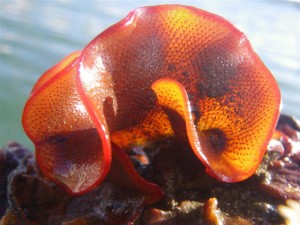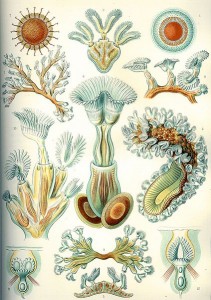By Katie Sinclair
All for one and one for all is a motto that bryozoans would take close to heart, if they had hearts, that is. This phylum is made up of 4,000 or so species, almost all of which are colonial. Individuals, called zooids, can’t survive on their own and depend on their fellow colony members to help gather nutrients, get rid of waste, and reproduce. Though sedentary as adults (a few species are able to creep slowly), bryozoans are able to spread through the dispersal of larvae in the water column. If a piece of the colony is broken off, it can survive and form a new colony. Known commonly as “moss animals” most bryozoans live up to the name, resembling robust pond scum. Some species, such as those in the Watersipora genus, form leaf-like, calcareous colonies that can serve as habitat for other animals.
While they may not be much to look at, bryozoans are prolific invaders. NEMESIS, a database of invasive species sponsored by SERC’s Marine Invasions Lab, recently updated their database to include over 20 invasive species of bryozoans. The site includes maps and graphs, showing where and how bryozoans have spread. The most common method for bryozoan introduction is hull fouling. Bryozoans are quickly able to colonize hard substrate in the water, including docks and boats.

A bryozoan in the Watersipora genus. Some species can grow even on anti-hull fouling paints containing copper and mercury.
Many bryozoan species are able to survive in brackish water. Some invasive species in the Watersipora genus are able to tolerate copper and mercury anti-fouling paint. While the exact ecological and commercial effects of invasive bryozoans in the Chesapeake are unknown, bryozoans can become nuisance animals, quickly fixing to newly-cleaned boat hulls and docks. Up north in the waters off Maine, Alcyonidium diaphanum, a species of bryozoan, is known to cause “Dogger Bank Itch” an eczema-like skin condition that primarily affects fishermen who come into contact with bryozoans that have affixed themselves to nets. There is evidence to suggest that several freshwater bryozoans can host parasites that can cause kidney disease in fish farms and hatcheries.
Next time you take your boat out for a spin and see some brown fuzz attached to your hull or dock, take a moment to consider the often-overlooked bryozoan. Bryozoans have existed in some form for over 450 million years, and their evolutionary relationships to other invertebrate phyla are still not fully understood by scientists. Diverse and widespread, bryozoan species can be found in large numbers from the tropics to the North Sea. As an invasive species, they can quickly take over any submerged surface. Check out the NEMESIS site to learn more about these fascinating species.



One of five invertebrate phylum yoked together in, “Animals Without Backbones” Third Edition. Buchshaum, Buschbaum, Pearce and Pea. Univ. Chicago, 1987 on inclusion criteria addressed in this very thoughtful piece.
Called moss animals because of tthe way some of them hang from ledgesvmoss like appearance. Some colonies are shrublike and hang from blades of kelp or from under rock ledges, seems associated with description?